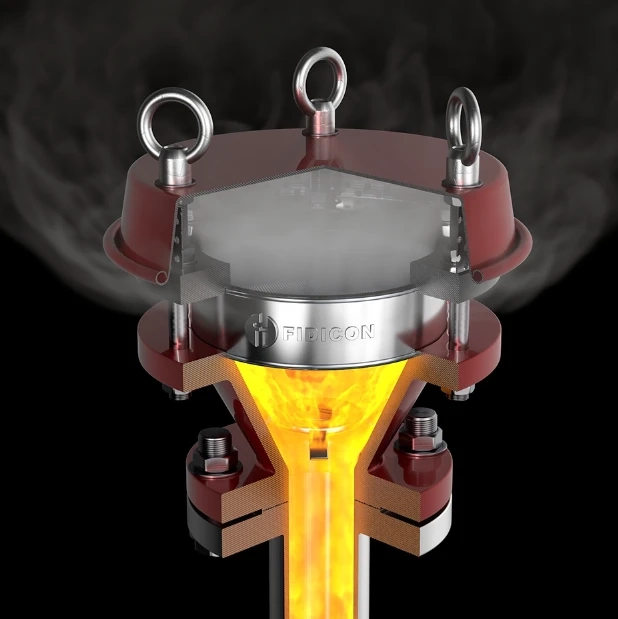Flame arresters are non-moving passive devices. They use a wound-crimped metal ribbon-type flame cell element to prevent flame propagation from the exposed side of the unit to the protected side.
This construction creates a matrix of uniform openings that are carefully designed to quench the flame by absorbing its heat. This creates an extinguishing barrier for the vapour mixture that has been ignited.
The flame arrester allows a relatively free flow of gas or vapour through the piping system under normal operating conditions. If the mixture is ignited and the flame begins to return through the piping, the arrester will prevent the flame from returning to the gas source.
In-line Deflagration or Detonation Flame Arrester
In-line flame arresters, also known as deflagration and detonation flame arresters, are the other major category. (In layman's terms, deflagration means rapid burning and detonation means explosion.) These devices are installed in pipes to keep flames from passing through.
The majority of in-line flame arrester applications are in gas collection systems for liquids and solids. These systems, which are common in many industries, are known as vapour control systems. Typically, the gases vented to the atmosphere or controlled by vapour control systems are flammable. If the conditions are such that ignition occurs, a flame could form inside or outside of the system, potentially causing catastrophic damage.
Vapor destruction systems are one type of vapour control system. Elevated flare systems, enclosed flare systems, burner and catalytic incineration systems, and waste gas boilers are all included.
Vapor recovery systems are another type of vapour control system that employs in-line flame arresters. Vapor balancing, refrigeration, adsorption, absorption, and compression systems are all included.
In-line flame arresters, on the other hand, are sometimes used in end-of-line applications. An in-line unit, for example, could be installed beneath a tank vent Valve on a liquid storage tank. The valve reduces emissions and product loss, while the flame arrester protects the tank from flames in the atmosphere when flammable gases are vented.
Selecting in-line flame arresters
Due to the tremendous energies associated with detonation pressure and flame velocity, the various dynamic states for confined flames described earlier can be extremely dangerous for a process system. Things happen quickly and can be disastrous. These multiple dynamic states make providing a flame arrester product or products that stop the flame and withstand the enormous pressures caused by explosions within the confined piping more difficult.
The extremely broad range of possible behaviour for a confined flame causes two distinct issues for flame arrester products. First, the high-pressure deflagration and stable detonation states have very stable burning kinetics, and the flame moves very quickly. As a result, the arrester must be able to absorb the heat of the flame much faster than standard low-to-medium-pressure deflagration conditions require. Second, the arrester is subjected to forces of up to 20995 kPa(g) due to the instantaneous impulse pressures caused by the shock waves of overdriven detonation (3000 psig). As a result, the arrester must outperform standard low-pressure deflagration arresters structurally.
Rupture Disc Manufacturer, Supplier, and Exporter in India
Rupture discs are non-reclosing safety devices with precisely defined breaking points. They respond very quickly to pressure and can be used to implement pressure relief in many different applications.
Check Out: https://fidicondevices.com/prod_category/rupture-disc/


